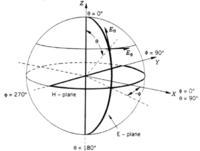kae_jolie
Full Member level 4
I am confused about which plane is the E-plane and which plane is the H-plane in a microstrip planar array.
There are two scenarios I find in the literature:
Scenario 1: E-plane is x-z plane where Φ= 0° and H-plane is the y-z plane where Φ= 90°
Scenario 2: E-plane is y-z plane where Φ= 90° and H-plane is the x-z plane where Φ= 0°
Could someone explain to me how I can tell for sure which is E-plane and which is H-plane? Is it related to the orientation of the length and width of the patch to the x- or y- axis? So if array is aligned along the x-axis, Scenario 1 is valid and if array is aligned along y-axis, Scenario 2 is valid? By array alignment along x-axis, I mean the patch width of each element of the array is aligned or in parallel with the x-axis.
Thanks.
There are two scenarios I find in the literature:
Scenario 1: E-plane is x-z plane where Φ= 0° and H-plane is the y-z plane where Φ= 90°
Scenario 2: E-plane is y-z plane where Φ= 90° and H-plane is the x-z plane where Φ= 0°
Could someone explain to me how I can tell for sure which is E-plane and which is H-plane? Is it related to the orientation of the length and width of the patch to the x- or y- axis? So if array is aligned along the x-axis, Scenario 1 is valid and if array is aligned along y-axis, Scenario 2 is valid? By array alignment along x-axis, I mean the patch width of each element of the array is aligned or in parallel with the x-axis.
Thanks.
